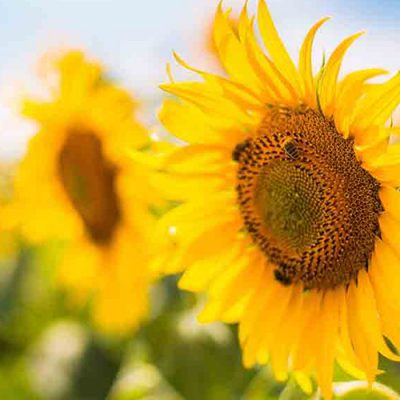Sunflower
Introduction
Globally, sunflower is mainly used for extraction of oil. But, in Sri Lanka it is still not grown as a commercial cultivation due to lack of intervention in developing it as an industry. The dry zone of Sri Lanka is well suited for sunflower cultivation.

Sunflower Cultivation
During the seed germination and early growth period moderate temperature is preferred. At the flowering stage and maturing stage hot climatic conditions are important. If the flowering stage can be overlapped with the time periods, where the bee populations are high, yield will be enhanced.
In loosely textured sandy soils as well as hard soils with moderately high clay content, sunflowers can be grown. But acidic soils with poor drainage is not suitable for commercial cultivation.
Maha season- End of October to early November
Yala Season- March to April
To date there are no recommended varieties available in Sri Lanka. Studies are continuing to identify a variety suitable for local conditions. Normally, there are two types of varieties available in other countries.
- Open pollinated varieties
- Seed production is comparatively easy. The oil yield is comparatively low (25-35%). The empty seed percentage can be high, if artificial pollination is not practiced.
- Hybrids
- Seed yield and oil yield is higher (45-50%) than open pollinated varieties. Most of the imported types are now hybrids. Therefore, seed production cannot be done locally.
13-16 Kg/ha
Between rows- 60cm
Within rows – 25cm
Deep ploughing followed by rotavating should be practiced and ridge and furrow or raised beds are most suitable. Plant one seed per hill according to the correct spacing.
Adequate soil moisture is very critical during the flowering period (7-8 weeks after emergence). Since there is a rapid growth during this period, supplementary irrigation is recommended once a week.
| Time of Application | Urea (Kg/ha) | TSP (Kg/ha) | MOP (Kg/ha) |
| Basal dressing | 65 | 100 | 50 |
| 1st top dressing (4 weeks after planting) | 50 | – | – |
| 2nd top dressing (8 weeks after planting) | 50 | – | – |
Note: Phosphorus and Potassium fertilizer application is recommended after field soil testing.
Only for open pollinated varieties, flowers should pollinate every other day using a clean cloth in order to promote the seed setting.
Manual weeding should be done during the early growth period of sunflower, where the growth rate is slow.
Pests
There are no severe pest damages known in sunflowers. Occasionally, sunflower moth can damage the immature seeds and other parts of the head.
Diseases
Following diseases can economically damage sunflower cultivation.
- Phoma black stem
Caused by a fungus called Phoma macdonaldii. Black lesions (1-2 inch) centered on petioles, in which multiple lesions can occur on the same stem. Ultimately, the plant may lodge and die.
Control
Destroy crop residues.
- Basal stalk rot
Caused by a fungus called Slerotinia sclerotiorum. Whole plant starts to wilt, white mold can be observed on the basal part of the plant.
Control
Improve the soil drainage.
Average seed yield is around 1000-1100 Kg/ha under rainfed conditions, while supplementary irrigation can increase the yield up to 1500-2000 Kg/ha.
Once the flowers mature petals will shed and the head becomes brownish color. Harvest individual flowers using a knife and dry them for 2-3 days. Then peel off the seeds from the head and sundry the seeds to reduce the moisture content up to 10%.
